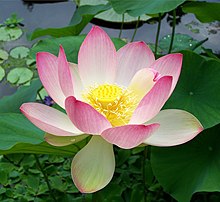Lotus position
Lotus position or Padmasana (Sanskrit: पद्मासन, romanized: padmāsana)[1] is a cross-legged sitting meditation pose from ancient India, in which each foot is placed on the opposite thigh.[2][28] Attempts to force the legs into lotus pose can injure the knees by squeezing and damaging the medial meniscus cartilage; this is painful and takes a long time to heal.[29] The yoga guru B. K. S. Iyengar notes that people unused to sitting on the floor will initially feel "excruciating" pain in the knees, but that this subsides with practice, until the pose becomes relaxing, both restful and alert and hence ideal for pranayama.[40] The scholar of religion Thomas Tweed wrote in 2008 that "the prevailing image of Buddhist practice has been the solitary meditator, eyes half closed, sitting in the lotus position.[43] The BBC journalist Megan Lane commented in 2003 that since yoga as exercise had become mainstream, lotus position (like tree pose) had been used by advertisers to sell "all manner of goods and services."[44] She noted that both "healthy living"[44] goods such as vitamins, fitness clubs, water filter and probiotic yogurt, and unrelated items such as cars, airlines, financial services "and even beer"[44] have made use of images of yoga to convey a message of well-being.The agency responded with a photograph of two young women meditating in lotus pose at dawn under the heading "Start your day with Jogi", the brand name also meaning "yoga" in Polish.

Sanskritromanizedmeditation poseancient Indiahatha yogameditationTantraBuddhistHinduismGautama BuddhaBuddhismTirthankarasJainismBuddhist meditationNelumbo nuciferaenlightenmentsacred lotusChineseTibetan BuddhismasanasChandragupta IItantricHatha Yoga PradipikaliberationSritattvanidhiDarshana Upanishadcross-leggedabdomencushionSirsasanaSarvangasanaSimhasanaMatsyasanaGorakshasanaVatayanasanaArdha MatsyendrasanaBharadvajameditatingPadma Sirsasanainjure the kneesmedial meniscuship jointsyoga guruB. K. S. IyengarpranayamaLotus throneshrineParshvanathaMahaviraIan FlemingYou Only Live TwiceJames Bondyoga as exercisetree poseused by advertisersprobioticKukkutasanaList of asanasMaravijayaPadmasana (shrine)BibcodeZimmer, Heinrich RobertSjoman, Norman E.Powers, SarahYoga JournalSwami Satyananda SaraswatiVishnudevanandaThe Complete Illustrated Book of YogaMetropolitan Museum of ArtBritish MuseumDorling KindersleyTuttle PublishingFleming, IanIyengar, B. K. S.Light on YogaJain, AndreaSelling YogaMallinson, JamesSingleton, MarkRoots of YogaNewcombe, SuzanneSaraswati, SatyanandaDrishtiSun SalutationVinyasaYoga as therapyAnjaneyasana (crescent moon)Bidalasana (cat)/Bitilasana (cow)Bhujangasana (cobra)Chakrasana (wheel) or Urdhva Dhanurasana (upward bow)Viparita Dandasana (inverted staff)Kapotasana (pigeon)Eka Pada Rajakapotasana (king pigeon)Ushtrasana (camel)Ashtavakrasana (8-angled)Bakasana (crane) or Kakasana (crow)Koundinyasana (the sage Kaundinya)Kukkutasana (cockerel)Mayurasana (peacock)Tittibhasana (firefly)Adho Mukha Svanasana (downward dog)Adho Mukha Vrkshasana (handstand)Halasana (plough)Sarvangasana (shoulderstand)Setu Bandha Sarvangasana (bridge)Shirshasana (headstand)Viparita Karani (legs up the wall)Vrischikasana (scorpion)Anantasana (Vishnu's couch)Ashtanga Namaskara (eight-limbed)Bhekasana (frog)Chaturanga Dandasana (low plank)Dhanurasana (bow)Jathara Parivartanasana (belly twist)Makarasana (crocodile)Matsyasana (fish)Shalabhasana (locust)Shavasana (corpse)Vasishtasana (side plank)Yoganidrasana (yogic sleep)Baddha Konasana (cobbler)Gomukhasana (cow face)Gorakshasana (cowherd)Siddhasana (accomplished)Simhasana (lion)Vajrasana (thunderbolt)